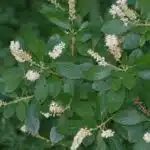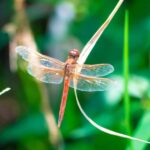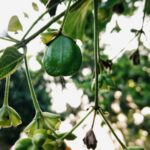Arrowwood Viburnum is a popular ornamental shrub with stunning features that make it a perfect addition to any garden or landscape. Scientifically known as Viburnum dentatum, this native North American species is revered for its hardiness, adaptability, and versatility. As a horticulturalist or arborist, you can recommend Arrowwood Viburnum to clients who are looking for an attractive shrub that requires minimal maintenance while providing year-round interest.
In this article, we will explore everything you need to know about growing and caring for Arrowwood Viburnum. We will discuss the plant’s ideal growing conditions such as soil type, sunlight exposure, and watering needs. Additionally, we will highlight common problems that may arise when growing Arrowwood Viburnum and provide practical solutions to ensure optimal growth and health. Whether you’re new to gardening or an experienced landscaper looking for new ideas, this article will equip you with the knowledge and skills necessary to cultivate a thriving Arrowwood Viburnum plant in your outdoor space.
Overview Of Arrowwood Viburnum
Arrowwood viburnum, also known as Viburnum dentatum, is a deciduous shrub that belongs to the Adoxaceae family. It is native to North America and can be found in various locations, including woodlands, swamps, and stream banks. This plant is known for its versatility and usefulness in different landscaping designs.
One of the uses of arrowwood viburnum is that it serves as an excellent hedge or screen plant due to its dense growth habit. It can grow up to 10 feet tall and wide with a rounded shape, making it ideal for creating a barrier between properties or for privacy purposes. Additionally, this shrub produces fragrant white flowers in spring and blue-black fruits in fall, which attract birds and wildlife.
There are several varieties of arrowwood viburnum available in the market today. Some popular cultivars include ‘Autumn Jazz,’ ‘Blue Muffin,’ ‘Chicago Lustre,’ and ‘Little Joe.’ Each variety has unique characteristics such as size, color, and growth habit. Choosing the right type of arrowwood viburnum depends on factors like soil type, sun exposure, and intended use. Therefore, it’s essential to do some research before selecting the best variety for your specific needs.
Arrowwood viburnum is a versatile shrub that offers numerous benefits to gardeners and landscapers alike. From serving as an attractive hedge or screen plant to providing food sources for wildlife, this plant is an excellent addition to any landscape design. In the next section, we will explore some of the benefits of growing arrowwood viburnum in more detail.
Benefits Of Growing Arrowwood Viburnum
Arrowwood viburnum is a versatile plant that offers several benefits to gardeners and landscapers alike. One of the greatest advantages of growing arrowwood viburnum is its adaptability to different soil types, including clay and loam. This plant can also withstand various environmental conditions, making it an ideal choice for those who live in regions with unpredictable weather patterns.
Aside from its resiliency, arrowwood viburnum is also prized for its aesthetic qualities. This shrub produces clusters of small white flowers in the springtime that emit a sweet fragrance. The blooms eventually give way to dark blue berries that are enjoyed by birds and other wildlife. The foliage of arrowwood viburnum turns shades of red and purple during the fall months, creating a stunning display of color.
The uses of arrowwood viburnum are not limited to ornamental purposes alone. This plant has been traditionally used by Native Americans for medicinal purposes, as it contains compounds that have anti-inflammatory properties. Additionally, the fruits of this shrub can be used to make jams or jellies, providing a tasty treat for those who enjoy homemade preserves. With all these benefits in mind, it’s no wonder why arrowwood viburnum is such a popular choice among gardeners and landscapers.
As you consider incorporating arrowwood viburnum into your landscape design, it’s important to note its climate and location requirements. While this plant can tolerate different soil types and environmental conditions, it does require full sun or partial shade to thrive. Arrowwood viburnum prefers moist soil but can tolerate some drought once established. By keeping these factors in mind when selecting a location for your arrowwood viburnum plants, you can ensure they will flourish and provide you with years of enjoyment.
Climate And Location Requirements
Arrowwood viburnum is a hardy shrub that is native to North America. It is known for its beautiful, white flowers and stunning foliage in the fall. However, growing arrowwood viburnum requires specific climate and location requirements that need to be met.
The ideal temperature range for growing arrowwood viburnum is between 60°F and 75°F. This temperature range allows the plant to thrive and produce healthy foliage and flowers. Additionally, it is important to note that arrowwood viburnum needs full sun or partial shade to grow properly. Growing conditions should also include well-draining soil with good air circulation.
It is recommended that you select a spot in your garden or landscape that has well-draining soil with a slightly acidic pH level between 5.0 and 6.5. Arrowwood viburnum prefers moist but not waterlogged soil, so it is important to ensure proper drainage before planting your shrub. Once you have selected the ideal location, you can begin preparing the soil for planting by removing any weeds or debris and adding organic matter such as compost or peat moss.
Moving on to the next section, understanding the appropriate soil type and preparation needed for growing arrowwood viburnum will help ensure a successful harvest of beautiful flowers and foliage.
Soil Type And Preparation
Soil pH should be tested and adjusted to the desired range before planting arrowwood viburnum. To ensure adequate fertility, organic matter and compost should be incorporated into the soil. Mulch should be used to help retain soil moisture, control weeds, and prevent nutrients from leaching. To ensure proper drainage, the planting depth should be considered, as well as aeration and water requirements, sunlight exposure, and wind protection.
Soil Ph
In order to grow healthy and thriving arrowwood viburnum, it is important to pay attention to the soil preparation process. One crucial aspect of soil type and preparation that horticulturalists must consider is soil pH. Arrowwood viburnum thrives in soils with a slightly acidic pH level ranging from 5.5-6.5. Therefore, it is necessary to test the acidity levels of the soil before planting and adjust as needed.
Soil acidity levels can affect plant growth in numerous ways, including nutrient availability and root development. If the soil pH is too high or alkaline, nutrients such as iron, magnesium, and manganese become less available for absorption by plants, leading to stunted growth or yellowing leaves. On the other hand, if the pH level is too low or acidic, bacteria may not be able to break down certain organic matter in the soil that releases essential nutrients for plant growth. Thus, maintaining an appropriate pH level through proper soil preparation can help ensure optimal growth conditions for arrowwood viburnum.
To adjust soil acidity levels for arrowwood viburnum cultivation, one can add organic matter like compost or peat moss to lower the pH level or apply lime to raise it. However, it is important to note that excessive use of lime can lead to an overly alkaline environment that may harm plant growth. Therefore, horticulturalists must carefully monitor their soil’s acidity levels and adjust accordingly during regular maintenance practices such as fertilization and watering routines. By doing so, they will provide their plants with an ideal growing environment that promotes strong root development and lush foliage without any unnecessary complications or stressors on their health.
Soil Fertility
In addition to soil pH, another crucial aspect of soil type and preparation that horticulturalists must consider is soil fertility. Soil fertility refers to the ability of the soil to provide essential nutrients for plant growth. Arrowwood viburnum requires well-draining soils that are rich in organic matter and nutrients for optimal growth. Poor soil fertility can lead to stunted growth, yellowing leaves, and even death of the plant. Therefore, it is crucial to improve soil fertility through proper soil preparation.
One way to improve soil fertility is by improving drainage. Poorly drained soils can lead to waterlogging and root rot, which can ultimately kill the plant. To improve drainage, horticulturalists can add organic matter like compost or peat moss to the soil. These organic amendments help break up heavy clay soils and increase water infiltration rates, thereby improving drainage and aeration.
Another way to improve soil fertility is by adding organic soil amendments like bone meal, blood meal, or fish emulsion. These amendments provide essential nutrients like nitrogen, phosphorus, and potassium that are necessary for plant growth. Additionally, they also help improve soil structure and water-holding capacity by increasing microbial activity in the soil. Overall, improving soil fertility through proper preparation techniques like adding organic amendments can lead to healthier arrowwood viburnum plants with stronger root systems and lush foliage.
Watering Needs
Did you know that the arrowwood viburnum is a drought-tolerant shrub? While it may be able to survive in dry conditions, proper watering is still necessary for optimal growth and health. The key to watering this shrub is to ensure that the soil is consistently moist but not waterlogged.
Watering frequency for arrowwood viburnum varies depending on factors such as weather conditions and soil type. It’s best to check the soil moisture level regularly by sticking your finger about an inch into the soil. If it feels dry, it’s time to water. During hot and dry periods, you may need to water more frequently than during cooler seasons. However, be cautious not to overwater as this can lead to root rot and other diseases.
When it comes to watering techniques, it’s best to water deeply but infrequently. This means providing enough water so that it reaches the roots but allowing enough time for the topsoil to dry out before watering again. A good rule of thumb is to provide one inch of water per week either through rainfall or irrigation. To prevent leaf scorch and other issues, avoid watering during midday when the sun is at its strongest.
Proper watering practices are essential for maintaining a healthy arrowwood viburnum shrub. However, sunlight and shade requirements also play a crucial role in its growth and development. To ensure your shrub thrives in all aspects, let’s take a closer look at its sunlight and shade requirements.
Sunlight And Shade Requirements
Arrowwood viburnum is a versatile shrub that can grow in a variety of light conditions. However, to achieve optimal growth and flowering, it’s best to plant them in full sun or partial shade. Full sun means exposing the plant to at least six hours of direct sunlight per day. On the other hand, partial shade means protecting the plant from intense afternoon heat.
Benefits and drawbacks come with each light condition for arrowwood viburnum. Growing them in full sun encourages robust growth and abundant flower production. Meanwhile, growing them in partial shade helps prevent leaf scorching during hot summer days. However, planting arrowwood viburnum in deep shade can result in reduced growth rate and sparse flowering.
To encourage optimal growth conditions for arrowwood viburnum, consider planting them on well-draining soil with sufficient moisture retention capacity. This type of soil structure will help promote root establishment and prevent waterlogging that may cause root rot disease. Moreover, proper soil preparation before planting may also improve nutrient uptake by the plant roots, resulting in better overall health and vitality.
Transition:
Now that we have discussed the ideal light conditions for arrowwood viburnum’s optimal growth let’s move on to fertilizing this shrub to ensure it reaches its full potential.
Fertilizing Arrowwood Viburnum
Like a chef adding seasoning to a dish, fertilizing is an essential part of growing and maintaining arrowwood viburnum plants. Fertilizers provide the necessary nutrients that support their growth, blooming, and overall health. However, not all fertilizers are created equal. Gardeners may choose between organic and synthetic fertilizers when feeding their plants.
Organic fertilizers contain natural components like manure or compost, which make them an eco-friendly option for gardeners. They release nutrients slowly over time, providing a steady stream of nourishment to the plants. On the other hand, synthetic fertilizers are chemically formulated to provide specific nutrients needed for plant growth. They work quickly but may contain harmful chemicals that can harm the environment in excessive amounts.
The best time to fertilize arrowwood viburnum is during its active growing season in spring or early summer. Start by testing the soil’s nutrient levels before applying any fertilizer to prevent over-fertilization. Follow the recommended amount on the fertilizer label and apply it evenly around the plant’s base without touching its leaves or stems. Remember to water it well after application to help distribute the nutrients throughout the soil and encourage absorption by the roots.
To keep your arrowwood viburnum looking healthy and beautiful year-round, pruning and trimming techniques are crucial. Let’s find out how we can maintain its shape and promote its flowering in our next section!
Pruning And Trimming Techniques
Pruning is an essential part of maintaining the health and appearance of your arrowwood viburnum. It should be done annually to remove any diseased or damaged branches, as well as to shape the plant. Pruning frequency will depend on how quickly your arrowwood viburnum grows, but it is generally recommended to prune in late winter or early spring before new growth appears.
When pruning your arrowwood viburnum, it’s important to use sharp, clean tools to avoid damaging the plant. Make cuts at a slight angle just above a bud or side branch, and avoid cutting into the main stem. Shaping techniques can vary depending on your desired look, but generally involve removing any crossing or crowded branches and encouraging outward growth by cutting back inward-facing branches.
By regularly pruning and shaping your arrowwood viburnum, you can help maintain its overall health and create a visually appealing landscape feature. In the next section, we’ll discuss how to propagate arrowwood viburnum through various methods.
Propagating Arrowwood Viburnum
After mastering the pruning and trimming techniques, propagating arrowwood viburnum is the next step in growing and expanding your collection. Propagation techniques vary from stem cuttings to layering, but stem cuttings are the most common method used. The best time to propagate is during the late spring or early summer when new growth is present.
To propagate using stem cuttings, locate a healthy branch that has not yet flowered. Take a 4-6 inch cutting with a sharp and clean pair of pruning shears. Remove any leaves from the bottom two-thirds of the cutting to prevent water loss. Dip the end of the cutting in rooting hormone powder, tap off any excess powder, and plant it in well-draining soil mix. Keep the soil moist and place in indirect light until roots develop in approximately 6-8 weeks.
Rooting hormone application plays a crucial role in successful propagation as it promotes root growth and reduces stress on the cutting. Rooting hormone can be found at local gardening centers or online retailers. For a higher success rate, use a powdered form of rooting hormone with indole-3-butyric acid (IBA) as an active ingredient when applying on cuttings. Once established, transplant into larger containers or outdoors into well-draining soil with partial shade until fully grown.
Moving forward from propagation techniques, maintaining healthy plants also involves identifying and managing common pests and diseases that may arise.
Common Pests And Diseases
- Leaf spot is a common fungal disease affecting arrowwood viburnum, causing yellow to brown spots on the leaves.
- Aphids are small, soft-bodied insects that can cause a decrease in vigor and damage to the foliage of arrowwood viburnum.
- Powdery mildew is a fungal disease that can cause a white, powdery coating on arrowwood viburnum foliage, leading to decreased vigor and stunted growth.
- Bacterial blight and scale are two other common pests that can affect arrowwood viburnum, while spider mites can also cause damage to foliage.
Leaf Spot
Leaf spot is a fungal disease that affects arrowwood viburnum plants. This disease can cause significant damage to the foliage of the plant and can even lead to defoliation if left untreated. As a horticulturalist, it is important to recognize the symptoms of leaf spot in order to prevent the spread of the disease and protect your plant.
Prevention techniques are crucial in controlling leaf spot in arrowwood viburnum plants. One effective method is to ensure proper spacing between plants, which allows for adequate air circulation and reduces humidity levels. Additionally, avoid overhead watering as this can increase moisture on the leaves, creating an ideal environment for fungal growth. Regularly inspecting your plants for signs of infection and removing any infected portions immediately can also help prevent further spread.
Fungal treatments can be used to control leaf spot once it has been identified. Treatment options include fungicide sprays or systemic treatments that are absorbed by the plant through its roots. As a horticulturalist, it is important to choose a treatment method that is appropriate for your specific situation and follow all label instructions carefully. With proper prevention techniques and prompt treatment methods, you can effectively control leaf spot in arrowwood viburnum plants, ensuring healthy growth and beautiful foliage throughout the growing season.
Aphids
Common pests and diseases can cause significant damage to arrowwood viburnum plants, affecting their overall health and appearance. One of the most common pests that affect these plants is aphids. These small insects can feed on the sap of the plant, causing distortion and discoloration of the leaves. As a horticulturalist, it is important to recognize the symptoms of aphid infestations in order to prevent significant damage to your plants.
Preventing aphid infestations involves regular inspection of your plants for signs of insect activity. Proper spacing between plants can also help reduce humidity levels and limit opportunities for aphids to spread from plant to plant. Natural remedies such as insecticidal soap or neem oil can be effective in controlling mild aphid infestations, while chemical treatments such as systemic insecticides may be necessary for severe cases.
It is important to note that while chemical treatments may be effective in controlling aphids, they should only be used as a last resort and with caution. Chemical treatments have the potential to harm beneficial insects and pollinators, which can have long-term effects on the ecosystem surrounding your plants. As a horticulturalist, it is important to consider all options when treating aphid infestations and choose methods that are safe for both your plant and the environment.
Prevention And Treatment Of Issues
Integrated pest and disease management is crucial when growing arrowwood viburnum. It involves identifying and preventing potential issues before they occur, or treating them immediately to prevent further damage. One common problem with arrowwood viburnum is the presence of aphids, which can cause leaf curling and stunted growth. To prevent aphid infestations, avoid over-fertilizing the plant and regularly monitor for signs of infestation. If necessary, use insecticidal soap or neem oil to treat the affected areas.
Soil amendments and mulching are also important aspects of caring for arrowwood viburnum. These practices help maintain soil moisture levels and provide necessary nutrients to support healthy growth. Add compost or organic matter to the soil before planting to improve drainage and increase soil fertility. In addition, applying a layer of mulch around the base of the plant can help conserve moisture and prevent weed growth.
Overall, proper care and maintenance are essential for keeping arrowwood viburnum healthy and thriving. By using integrated pest and disease management strategies, as well as incorporating soil amendments and mulching practices, you can ensure that your plants remain strong and vibrant year after year. In the next section, we will discuss companion planting with arrowwood viburnum to maximize its benefits in your garden.
Companion Planting With Arrowwood Viburnum
Arrowwood Viburnum is an ideal shrub for companion planting, as it has many beneficial companion plants that can help it thrive. Flowers such as azaleas, hydrangeas and roses can be planted near Arrowwood Viburnum to invite pollinators and help promote healthy growth. Conversely, it is important to avoid planting incompatible species near Arrowwood Viburnum, such as grasses and small shrubs, as they can compete for nutrients and water. To ensure that Arrowwood Viburnum remains healthy and strong, it is important to research the best companion plants before planting.
Beneficial Companions
Pollinator attractors are plants that attract and support pollinating insects such as bees, butterflies, and moths. Arrowwood viburnum is an excellent pollinator attractor due to its abundant nectar production and showy flowers. However, planting arrowwood viburnum alongside other pollinator attractors can significantly increase the number of visiting insects in your garden. Good companions for arrowwood viburnum include bee balm, goldenrod, and asters.
Edible landscaping involves incorporating edible plants into your landscape design to produce both aesthetically pleasing and functional gardens. Arrowwood viburnum is a versatile plant that can be used for both ornamental purposes and as a source of food for humans and wildlife alike. Planting arrowwood viburnum alongside other edible plants such as blueberries or raspberries can create a beautiful yet productive garden space.
In conclusion, planting arrowwood viburnum with beneficial companions can enhance the overall health of your garden ecosystem. Pollinator attractors like bee balm and asters can increase the number of visiting insects while edible plants like blueberries or raspberries provide a food source for both people and wildlife. By incorporating these concepts into your garden design, you can create a beautiful and functional space that serves both yourself and the environment.
Incompatible Companions
Plant compatibility is a crucial consideration when designing a garden space. While it is essential to select beneficial companions for arrowwood viburnum, it is equally important to avoid planting incompatible plants that can cause potential harm. Incompatible companions are plants that compete for resources or emit chemicals that negatively affect the growth and health of other plants.
One example of an incompatible companion for arrowwood viburnum is black walnut trees. Black walnut trees release a chemical called juglone, which can be toxic to many plants, including arrowwood viburnum. This chemical can inhibit the growth and development of arrowwood viburnum, leading to stunted growth, yellowing leaves, and even death. Therefore, it is best to avoid planting arrowwood viburnum near black walnut trees.
Another example of an incompatible companion for arrowwood viburnum is silver maple trees. Silver maple trees have a shallow root system that can compete with the roots of arrowwood viburnum for nutrients and water. This competition can cause stress on both plants, leading to poor growth and reduced flower production in arrowwood viburnum. To avoid this issue, it is best to plant arrowwood viburnum away from silver maple trees.
In conclusion, selecting compatible companions for arrowwood viburnum is essential in creating a healthy and thriving garden ecosystem. Plant compatibility should be carefully considered to prevent any potential harm caused by incompatible companions such as black walnut and silver maple trees. By avoiding these harmful plant combinations and choosing beneficial companions instead, you can create a beautiful garden space that serves both yourself and the environment.
Using Arrowwood Viburnum In Landscaping
Companion planting with Arrowwood Viburnum is a great way to add texture, color, and diversity to your garden. This shrub is not only versatile but also easy to care for. It can be planted with other shrubs, perennials, and annuals to create a beautiful and functional garden space. Some great companion plants for Arrowwood Viburnum include Black-eyed Susan, Purple Coneflower, and Russian Sage.
Design ideas for incorporating Arrowwood Viburnum into your landscaping are endless. You can use it as a specimen plant or in mass plantings as a hedge or screen. Its dense foliage and attractive flowers make it an excellent choice for creating privacy or blocking unwanted views. Additionally, this shrub attracts pollinators such as butterflies and bees to your garden.
Maintenance tips for Arrowwood Viburnum include pruning and fertilizing. Pruning should be done in early spring before the new growth appears. You can remove dead or damaged branches and shape the shrub according to your desired size and shape. Fertilizing should be done in early spring using a slow-release fertilizer specifically designed for shrubs.
As the seasons change, seasonal care tips for Arrowwood Viburnum may vary. In the next section, we will discuss how to care for this versatile shrub during different seasons of the year to ensure its optimal growth and beauty in your garden space.
Seasonal Care Tips
Arrowwood viburnum is a low-maintenance shrub that requires minimal care. However, to maintain its health and beauty, it is crucial to provide seasonal care. During spring and summer, the arrowwood viburnum produces beautiful flowers and foliage. To encourage healthy growth during this period, it is advisable to fertilize the plant with balanced fertilizer. Additionally, regular pruning of dead or diseased branches will promote optimal growth.
Mulching techniques are essential for maintaining soil moisture and preventing weed growth around the arrowwood viburnum. Mulch should not be placed too close to the base of the plant to avoid stem rotting. Instead, spread a 2-3 inch layer of mulch around the plant’s drip line. This technique can help retain soil moisture during hot summers while also providing nutrients as the mulch decomposes.
Winter protection is necessary for arrowwood viburnum as they are susceptible to winter damage in extremely cold climates. To protect them from cold winds and frostbite, wrap burlap around them before winter sets in. This technique can help maintain their health and prevent damage caused by freezing temperatures.
Moving on to troubleshooting common problems…
Troubleshooting Common Problems
Anticipated Objection: Many gardeners have reported leaf discoloration and pest infestations on their arrowwood viburnum plants, making it difficult to maintain a healthy plant. However, with proper care and attention, these issues can be avoided.
One common problem that arrowwood viburnum plants face is leaf discoloration. This can occur due to several reasons such as poor soil quality, lack of sunlight, or overwatering. To avoid this issue, it is important to ensure that the soil is well-draining and rich in nutrients. Additionally, the plant should receive enough sunlight for at least 6 hours a day. Overwatering should be avoided as it can lead to root rot and other fungal diseases.
Pest infestations are another issue that arrowwood viburnum plants may encounter. Common pests include aphids, spider mites, and scale insects. These pests can cause damage to the leaves and stems of the plant resulting in stunted growth or even death. To prevent pest infestations, regular inspections of the plant should be conducted. If any pests are detected, appropriate measures should be taken immediately such as using insecticidal soap or neem oil spray.
| Common Problems | Solutions |
|---|---|
| Leaf discoloration | Ensure well-draining soil and adequate sunlight; avoid overwatering |
| Pest infestations | Regular inspections; use insecticidal soap or neem oil spray if necessary |
By following these simple steps and regularly monitoring your arrowwood viburnum plant for any issues, you can enjoy a healthy and thriving plant in your garden for years to come. Remember that prevention is key when it comes to maintaining a healthy plant – taking proactive measures will save you time and money in the long run.
Frequently Asked Questions
Can Arrowwood Viburnum Be Grown In Containers Or Pots?
Container gardening is a popular alternative to traditional gardening methods, especially for those who have limited space. When it comes to arrowwood viburnum, growing them in containers or pots is possible. However, it is important to consider the plant spacing requirements as this can affect their growth and overall health. Arrowwood viburnums need adequate space for their root system to grow and develop properly. Therefore, choosing a container that allows for enough soil volume and drainage is crucial. Additionally, proper care such as regular watering and fertilization should also be taken into account when growing arrowwood viburnum in containers. With proper attention to detail, container-grown arrowwood viburnum can thrive just as well as those planted directly in the ground.
What Is The Average Lifespan Of An Arrowwood Viburnum Plant?
The lifespan of an arrowwood viburnum plant can vary depending on various factors such as growing conditions and pruning techniques. Generally, an arrowwood viburnum plant can live up to 50 years or more if it is grown in optimal conditions. These plants require well-draining soil with a pH level between 5.5 and 7.5, full sun exposure, and regular watering. Pruning should be done during the dormant season to encourage new growth and remove any dead or damaged branches. With proper care and maintenance, arrowwood viburnum plants can thrive for many years, providing beauty and benefits to their surroundings.
How Often Should Arrowwood Viburnum Be Fertilized?
As the old adage goes, “you reap what you sow.” When it comes to fertilizing arrowwood viburnum, this rings true. Choosing between organic and chemical fertilizers can impact the health and longevity of your plant. While both options have their benefits, organic fertilizers offer a more sustainable approach by providing slow-release nutrients that promote healthy growth without harming the environment. When it comes to timing, the best time to fertilize arrowwood viburnum is in early spring before new growth begins. It’s important to avoid over-fertilization as this can lead to excessive growth and weaken the plant’s overall health. As a horticulturalist or arborist, it’s our duty to provide sound advice for those looking to care for their plants. By choosing the right fertilizer and timing its application correctly, we can help ensure that arrowwood viburnum thrives for years to come.
Is Arrowwood Viburnum Deer-Resistant?
When designing a landscape, it is important to consider the potential impact of deer on your plants. Arrowwood viburnum is a popular shrub amongst homeowners due to its beautiful blooms and attractive fruit. However, it may be vulnerable to browsing by deer. While no plant can be considered completely deer-resistant, arrowwood viburnum is known for its moderate level of resistance. This means that it may still be targeted by deer during times of food scarcity or if there are no other suitable options available. It is recommended to incorporate other deer-resistant plants in your landscape design to help deter browsing and protect your arrowwood viburnum from damage.
Can Arrowwood Viburnum Tolerate High Winds Or Salt Spray From The Ocean?
Wind-resistant landscaping is often a concern for coastal homeowners, as strong winds and salt spray from the ocean can damage delicate shrubs and trees. When selecting plants for coastal gardens, it’s important to look for species that are both wind-resistant and salt-tolerant. Arrowwood viburnum (Viburnum dentatum) is a deciduous shrub that can thrive in coastal environments, thanks to its tolerance of salt and ability to withstand moderate winds. While it may not be able to tolerate hurricane-force gusts or heavy salt spray, arrowwood viburnum is an excellent choice for homeowners looking to add hardy, low-maintenance shrubs to their landscape.
Conclusion
Arrowwood viburnum is a popular ornamental plant that can be grown in a variety of soil types and climatic conditions. While it is often grown as a shrub, it can also be trained to grow as a small tree. Although the plant is relatively easy to care for, there are several factors that need to be considered to ensure its healthy growth.
Firstly, it is important to note that arrowwood viburnum can be grown in containers or pots but it requires regular watering and fertilization. Secondly, the average lifespan of an arrowwood viburnum plant is approximately 20-30 years, depending on the growing conditions and maintenance practices. Thirdly, the plant should be fertilized once every year with a slow-release fertilizer to promote healthy growth.
Furthermore, arrowwood viburnum is deer-resistant which makes it an ideal choice for gardens located in areas with high deer populations. Lastly, while arrowwood viburnum can tolerate high winds, salt spray from the ocean may damage the leaves and branches of the plant.
In conclusion, growing and caring for arrowwood viburnum requires attention to detail and proper maintenance practices. As they say, “you reap what you sow” – taking good care of your plants will reward you with beautiful blooms and healthy growth for years to come.
Image Credits
- “Arrowwood (Viburnum x bodnantense)” by chrisotruro (featured)





























